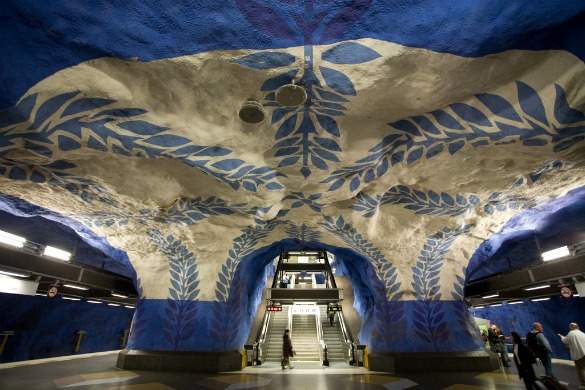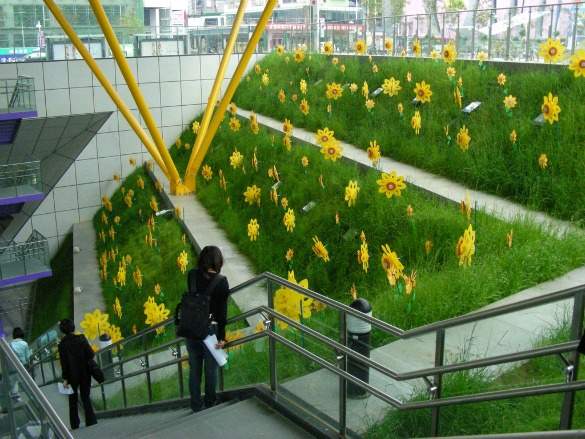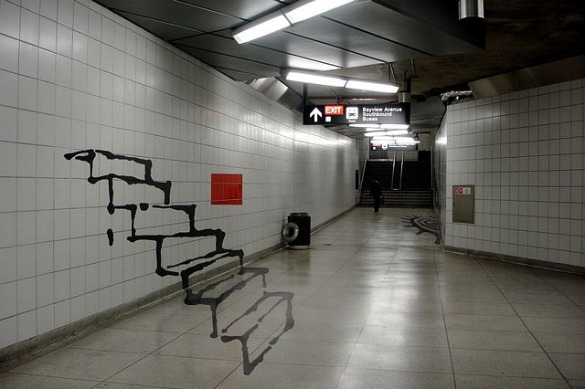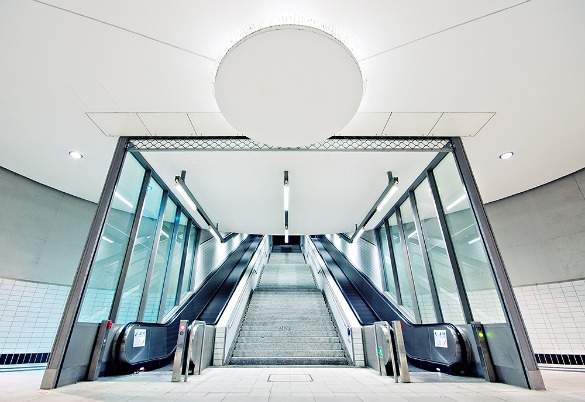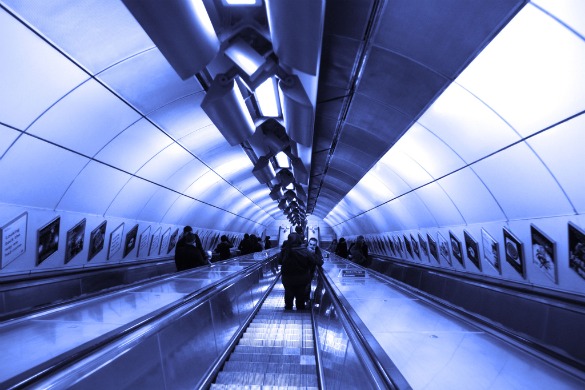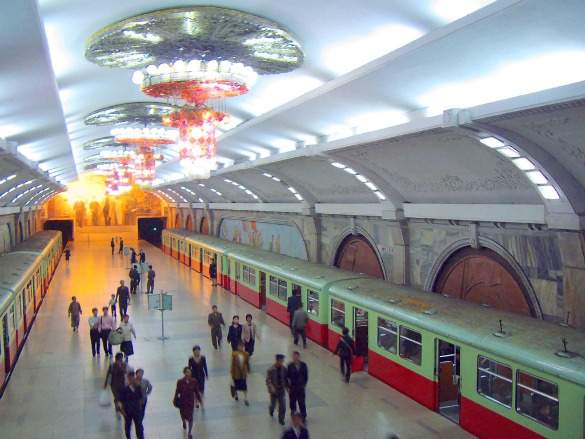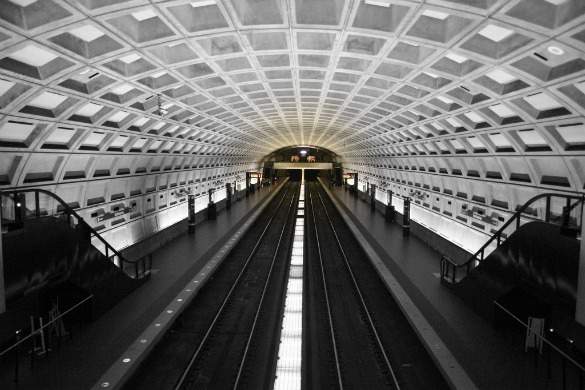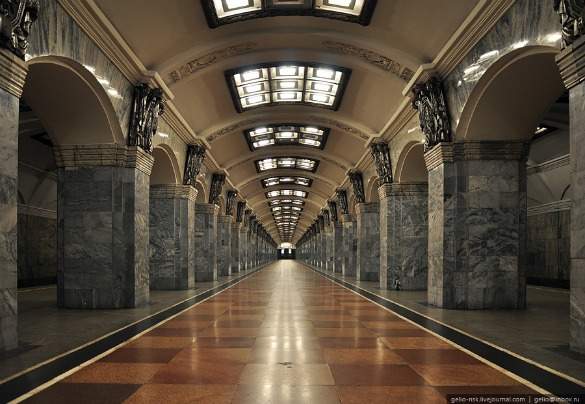Clearly, the first and foremost purpose of a subway station is to be a place where passengers can transition effectively from one train to another. However, as a location where masses of people flock to every day, subway stops can come to serve more than a mere practical purpose. They can become exhibition halls of great art and architecture, showcasing a country’s or city’s cultural treasures. Time-old subway stops in particular can come to represent the history of a place, allowing passengers to travel back in time as they walk the long corridors filled with antique chandeliers and other decadent embellishment. Recently renovated or entirely new subway stations, in turn, can reflect the newest technology and become a landmark of innovation.
[social]
Here are 15 of the coolest and most beautiful subway stops you can consider visiting on your travels. Who thought seeing art, architecture, culture, history and technology could all be done on the budget of using public transport?
1. Champ-de-Mars Station -Montreal, Canada
Champ-de-Mars Station opened on October 14th, 1966, as part of the initial subway network of Montreal. Situated in Old Montreal in the Ville-Marie borough, the station is now on the Orange Line of the Montreal Metro rapid transit system. The station is particularly spectacular on a sunny day, when light enters the stained glass windows by Automatiste painter Marcelle Ferron. The windows comprise of of the artist’s masterpieces and according to some, are her most famous work. Back in 1968, they were given by the Government of Quebec as the first work of non-figurative art commissioned for the metro.
>> Book a flight to Montreal
2. Formosa Boulevard Station – Kaohsiung, Taiwan
Formosa Boulevard is one of the busiest stations in Kaohsiung city, and also one of the most beautiful. In addition to being the place where the Red and Orange subway lines meet, the stop is also the location of the “Dome of Light.” The “Dome of Light,” situated on the upper part of the station, is known as the biggest public art installation all over the globe. We thank the artist Narcissus Quagliata for putting together the dome in a little less than four years, which included shipping pieces of colored glass directly from Germany.
The “Dome of Light” spans a 30-meter diameter. As you walk around, you can view the story of human life, transitioning from the section that represents water, the womb of life, to earth, which embodies the act of growing and prospering. After that, there are sections on light and fire, the latter representing on the one hand destruction and on the latter rebirth. The most important message that pervades the dome, however, is one of love and tolerance. You can find out more about it here.
>> Check out some unique modes of transport in Asia
3. T-Centralen Station -Stockholm, Sweden
In “T-Centralen,” “T” is an abbreviation for “tunnelbana,” which in Swedish means “underground” or “subway.” The T-Centralen station is the core of the Stockholm Metro; that is, it is the only station in which all of the three lines (Tub1, Tub2, and Tub3) meet. As such, it is the subway station with the highest traffic in Stockholm.
To be exact, the station consists of two sections: one for Tub1 and Tub2, and one for Tub3. The latter is shown above and is different from the other two in its appearance. Back in the 1950s, artists Vera Nilsson and Siri Derkert proposed that art should be part of the new subway system. The Tub3 section of the station is where the Blue Line runs, thus the blue and white artwork, which dates back to the 1970s. Inspired by Nilsson’s and Derkert’s pioneering idea, there are now more than 140 artists represented in 90 of Stockholm’s metro stations, including both permanent and temporary exhibitions. You can read more about the T-Centralen stop here.
>> Find out how to visit Stockholm on a budget
4. Central Park Station Station – Kaohsiung, Taiwan
Named after the nearby Central Park, this station lies on the Red Line of the Kaohsiung subway. A two-level underground station, the Central Park stop was designed by British architect Richard Rogers. Design-wise, purple is the pervading color throughout the station. The courtyard grass areas, in turn, are covered in a slope of yellow windmills shaped liked sunflowers. Read more about Kaohsiung metro art here.
5. Bayview Station – Toronto, Canada
Bayview Station, a stop on the Sheppard line, is one of the most recent additions to the Toronto subway system; it opened in 2002. The station was designed by Stevens Group Architects, who were responsible for the high-ceiling entrance pavilions with long, angled roofs that overhang the structure.
Throughout the station, you can see From Here Right Now, a trompe l’oeil installation by Toronto artist Panya Clark Espinal. Her website explains that in From Here Right Now, “twenty-four hand-drawn images have been ‘projected’ onto the architecture of the station so that when seen from the original location of projection, the images are crystalized and realistic, but when seen from other locations they appear to be abstractions. These images act as beacons, drawing the viewers along various paths of movement. Depicting everyday objects and simple geometric shapes, the images are rendered in an uncommonly large scale and in unusual orientations, allowing one to interact playfully with them as one moves through the space.”
Read our indie travel tips for visiting Toronto, Canada
6. Bockenheimer Warte Station – Frankfurt, Germany
The Bockenheimer Warte Station is one of the most important transfer stations of the Frankfurt subway system. Here the C-line crosses with the U6 and U7, as well as the U4 which runs in the D-tunnel. You can also transfer to various bus lines and trams here.
The construction of this station was first begun in 1986, and expanded in 2001. The station is worth viewing not only for its underground architecture, but also for one of its subway entrances. Click here to see the unique entrance, which looks like a train bursting through the sidewalk from below. Architect Zbiginiew Peter Pininski reported he felt inspired by surrealist artist René Magritte when creating it.
7. Bund Sightseeing Tunnel – Shanghai, China
If we were to speak in very strict terms, the Bund Sightseeing Tunnel is not a metro stop. As the name “sightseeing tunnel” suggests, it is a touristic tunnel, running below the Pu river.
Small cable cars take visitors from one end of the tunnel to the other. Throughout the ride, the tourists are entertained visually with lighting in all colors you can imagine. A puppet might also occasionally wave at you, or a movie screen might appear and disappear again. All along, there’s house music blasting so your ears enjoy the journey, too.
Click here to see a video of the entire trip.
>> See some of the most scenic train rides in the world
>> Check out these indie travel tips for Shanghai.
8. Slavyansky Bulvar Station – Moscow, Russia
The Moscow International Portal describes the stations of the Moscow subway as “underground palaces of Moscow.” With their magnificent vestibules and underground halls, often decorated with chandeliers, they certainly merit this description. Many of the stations are linked with the city’s history; while old, pre-war stations represent Russia’s industrialization, post-war stops embody the pleasure of victory and pride that was felt by the inhabitants at the time.
Opened on September 7th, 2008, the Slavyansky Bulvar station is one of the newest additions to the Moscow subway system. Its wrought iron and lamps are deliberately reminiscent of the Parisian metro. You can view more photos of the station here.
9. Kennington Station – London, U.K.
Opened on December 18th, 1890, the Kennington station is part of London’s first deep-level tube, the City & South London Railway (C&SLR). In contrast to other original C&SLR stations, the surface of the Kennington station building has suffered very little changes. As such, it is the only station of the C&SLR that still very much retains its original design. After its first extensive refurbishment in over 80 years, the station has now reopened for public use.
>> Learn more about the London Tube
10. Changi Airport MRT Station – Singapore
Changi Airport Mass Rapid Transit (MRT) Station was opened on February 8th, 2002. It serves as a pedestrian link between Terminals 2 and 3, as well as a connection to Singapore Expo, the largest convention and exhibition venue in Singapore with over 100,000 square meters of column-free, indoor space spread over 10 halls.
At each end, the station is anchored by a 35m tall glass atrium, where vertical circulation between the terminal levels is concentrated. So that the maximum amount of daylight can enter the station’s lower levels, the glass curtain walls are supported by a minimal cable truss structure, which evokes a sense of lightness and transparency.
11. Zoloti Vorota Station – Kiev, Ukraine
Zoloti Vorota station is one of Kiev’s most well-known subway stops. It is named after the Golden Gates historical structure, and opened as part of the first stage of the Syretsko-Pecherska Line on December 30, 1989. A series of architects contributed to the design, yet the station itself was constructed thanks to Boris and his son Vadim Zhezherin, as well as the artistic architects S.Adamenko and M.Ralko.
It contains a column trivault with the theme of the Architecture of Kievan Rus. To be seen are large chandeliers with light bulbs in the shape of candles. Mosaics by artists G. Koren and V. Fedko can be found on the vault and columns, which are made of white marble with a matte polish, while the floor is made of granite.
12. Olaias Station – Lisbon, Portugal
The purpose of the Olaias station was to link the inner city with the Expo ’98 area. It was designed by Portuguese architect Tomás Taveira and a team of Portuguese artists, including Pedro Cabrita Reis, Graça Pereira Coutinho, Pedro Calapez and Rui Sanchez. Like many others in Portugal, it boasts a contemporary interior design, including dramatic coloring and exquisitely crafted tiles. The International Architecture Yearbook, Issue 5, provides a great overview of the artistic highlights of the station.
>> Read more about getting around in Lisbon
13. Puhung Station – Pyongyang, North Korea
In 1973, North Korea needed subway stops that could also function as bomb shelters. For this reason, the Puhung stop, like many others in the city, was built 110 meters underneath the ground. Puhung means “Reconstruction” and reflects the revolutionary words that are used to refer to the stations throughout the city. There are others named Yonggwang (Glory), Hwanggumbol (Golden Fields), Pulgunbyol (Red Star) and Chonru (Comrade), for example.
The photo above shows a view from the staircase above the station platform, where you can see the elaborate decorations and chandeliers. At the other end is the mosaic “The Great Leader Kim II Sung Among Workers,” which you can view here. For video footage of the stop, click here.
14. Federal Triangle Station – Washington D.C., U.S.A.
The Federal Triangle station currently provides service for the Blue and Orange Lines of the Washington Metropolitan Area Transit Authority (WMATA). In the future, it will also be on the Silver Line route. It was opened on July 1st, 1977, and on January 13th, 1982, was the unfortunate location of the system’s first failure when an eastbound Metro train on the Orange Line derailed just east of the station resulting in three fatalities.
Check out our indie travel tips for visiting Washington DC
15. Kirovsky Zavod Station – St. Petersburg, Russia
The St. Petersburg subway might not be as majestic as its Moscow counterpart, but it is still impressive. In fact, it deserves a mention simply because it is the deepest subway in the world by the average depth of all the stations.
The Kirovsky Zavod station opened on November 15th, 1955. Its name comes from the Kirov factory, which is nearby. In addition to grand halls and checkered floors, you can see a statue of Lenin here. Watch a video here or view some more pictures here.
Read more about transportation around the world:
- The Most Beautiful Metro Stations in Paris
- 8 Unusual Transit Systems in the World
- 11 of the World’s Coolest Train Stations
- The First Timer’s Guide to Train Travel in Europe
Photos: jpmartineau, wisefly, Milton CJ, hiroshiken, wecand, cwangdom, Robbie1, somebody_, neiljs, magnusvk, kalevkevad, Jaime.silva, yeowatzup, Genista, Socialism Expo.


